A 2021 guide to central heating controls | wireless | digital | dial | advanced

Which central heating thermostat is right for my system?
Thermostats either turn your boiler on and off in a basic way or they are capable of passing data/information back to the boiler to help it operate more efficiently, aka advanced heating controls. For the thermostat to pass information back to the boiler it must speak the same language. Not all thermostats speak the same language as the boilers so you have to be very careful in your selection. Whilst we have attempted to provide a lot of detail here, picking the right heating control is difficult; getting it set up correctly with the boiler (i.e. finding the right installer) is even harder.
The tables below set out standard thermostats/programmers and advanced heating controls. There are lots of links off to other pages to provide more detail where necessary. If you get stuck you can always use our 1-2-1 services to get it right first time, go to How We Work for more.
1) Programmable room thermostats overview
Traditional programmable room stats turn the boiler on and off, for example if you only want your boiler to come on in the mornings and before you get home from work as well as set the room temperature. A standard central heating programmer (or programmable thermostat) will allow you to set the boiler to come on at the same times each day, for example, from 6am – 8am and 5pm until 9pm.
If you want to set different times on different days, you will need what is called a ‘seven-day’ programmable thermostat. Combi, heat only and system boilers are compatible with programmable thermostats but you will need to factor in hot water controls if you have a heat only or system boiler.
Advanced controls are also programmable room stats but have the addition of operating the boiler more efficiently during its periods of operation.
Programmable thermostats for combi boilers
A programmable thermostat for a combi boiler need only control the heating, as the hot water is instantaneous. The table below shows a selection of standard and smart programmable thermostats from Honeywell, Baxi, Ideal, Nest, Tado and Drayon. This is called a ‘single channel’ programmer. The single channel (as in radio channel) is for the thermostat to send a signal to the boiler. NB these are compatible with heat only and system boilers however a separate control for hot water will be required. Under the new Boiler Plus regulations a new combi boiler must be fitted with an ‘advanced heating control’ (see below).
| wireless thermostats with programmers (non smart control) | Honeywell T4R 7 day programmable thermostat | Honeywell RF2 Sundial Pack 2 wireless programmable room thermostat | Danfoss TPOne-RF programmable room thermostat | Nest thermostat E | Honeywell Lyric T6 Wireless Smart Thermostat | Tado smart thermostat Starter Kit V3+ with hot water | Ideal Wireless Programmable Room Thermostat | Baxi Usense Smart room thermostat |
|---|---|---|---|---|---|---|---|---|
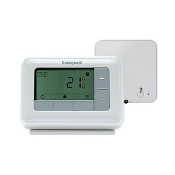 |
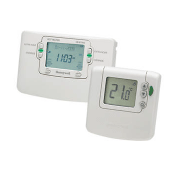 |
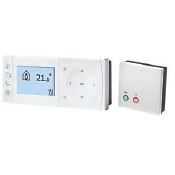 |
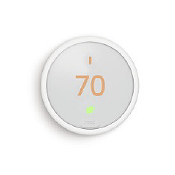 |
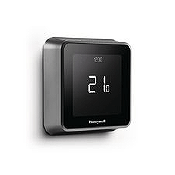 |
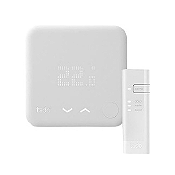 |
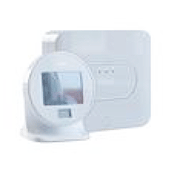 |
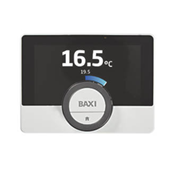 |
|
| Price | £118 | £163.00 | £135.00 | £178.00 | £145.00 | £160.00 | £160.00 | £160.00 |
| Display | Digital | Digital | Digital | Touch screen | Touch screen | Touch screen | Touch screen | Touch screen |
| No of days | 7 day | 7 day | 7 day | 7 day | 7 day | 7 day | 5 day | 6 day |
| Smart phone app | No | No | No | Yes | Yes | Yes | Yes | Yes |
| Warranty | 1 year | 1 year | 1 year | 2 years | 1 year | 2 years | 5-10 years with new boiler | 3 years |
| Compatible boiler types | All boiler types | Heat only and system | All boiler types | All boiler types | All boiler types | All boiler types | Combis only | Baxi 600, 400, 200 and 100 Combis |
| Intergal hot water control | No | No | No | Yes | Yes | Yes | No | No |
| Heat zone capability | 1 heating zone | 1 + hot water | 1 heating zone | 2 + hot water | 1 heating zone | 1 heating zone | 1 heating zone | 1 heating zone |
| Weather , load or smart automation | Load | Load | Smart automation and optimisation | Load and smart automation | Weather and load compensation | Smart automation and optimisation | Load and smart automation | Load compensation |
| TPI software | Yes | Yes | Yes | Yes | Yes | Yes | No | No |
| OpenTherm | Yes | Yes | No | Yes | Yes | Yes | Yes | Yes |
| Boiler Plus compliant for combis? | Yes | Yes | Yes | Yes | Yes | Yes | Yes | Yes when paired with a compatible boiler |
| Boiler Plus compliant for heat only and system? | Yes | Yes | Yes | yes | Yes | Yes | Yes | Yes |
Programmable thermostats to work with heating + a hot water tank
If you wish to control your heating and hot water from a single control you will need a programmable room thermostat with two channels: one to signal to the boiler to come on and one to control the hot water. It is common to have a two-channel programmer and separate thermostat, although we have only considered combined heating and hot water units below. We review a mix of standard and smart programmable thermostats from Honeywell, Myson, Worcester, Vaillant, Nest and Tado. For more programmable thermostats try our Guide to Wireless Programmable Thermostats.
| wireless thermostats for heating and hot water | Honeywell RF2 Sundial Pack 2 wireless programmable room thermostat | Myson Touch programmable room thermostat | Vaillant VRC700F Wireless weather compensating programmable room thermostat | Worcester Comfort II programmable room thermostat | Nest thermostat E | Honeywell Lyric T6R - HW wireless smart programmable thermostat | Tado smart thermostat Starter Kit V3+ hot water kit | Drayton Wiser thermostat Kit 2 |
|---|---|---|---|---|---|---|---|---|
 |
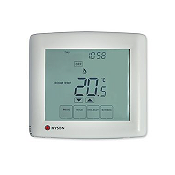 |
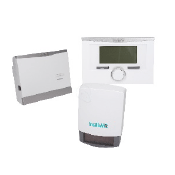 |
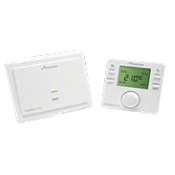 |
 |
 |
 |
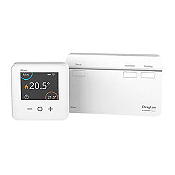 |
|
| Price | £163.00 | £80.00 | £200.00 | £210.00 | £178.00 | £185.00 | £239.00 | £159.00 |
| Screen | Digital | Touch screen | Digital and dial | Digital and dial | Touch screen | Touch screen | Touch screen | Touch screen |
| 7 day | 7 day | 7 day | 7 day | 7 day | 7 day | 7 day | 7 day | 7 day |
| Smart phone app | No | No | No | No | Yes | Yes | Yes | Yes |
| Hot water temperature controls included? | Yes | Yes | Yes | Yes | Yes | Yes | Yes | Yes |
| Warranty | 1 year | 2 years | 2 years | 8-10 years when fitted with a new Worcester boiler | 2 years | 1 year | 2 years | 1 year |
| Compatible boiler types | Heat only and system | Heat only and system | All current Vaillant boiler models | All combi & system boilers and 27 and 30Ri heat only boilers | All boiler types | All boiler types | All boiler types | All boiler types |
| Weather, load or smart automation | Load | Load | Weather and load | Load | Load and smart automation | Weather and load compensation | Smart automation and optimisation | Load and smart automation |
| TPI software | Yes | No | No | No | Yes | Yes | yes | No |
| OpenTherm | Yes | No | No | No | Yes | Yes | Yes | No |
| Boiler Plus compliant for heat only and system? | Yes | Yes | Yes | Yes | Yes | No | Yes | Yes |
| Zones | 2 heating zones | 1 heating zone | 2 heating zones | 2 heating zones | 3 zones with pipework or more with Energenie smart TRVs | 2 | 1 heating zone | 2 (kit 3 can give 3 zones) |
2) Stand alone room thermostats for existing boilers
At their most basic, heating controls tell the boiler to come on and go off via a room thermostat. A room thermostat is set to the desired temperature and it will tell the boiler to come on until that room temperature is reached. Once reached, the thermostat will tell the boiler to go off again. These take the form of a digital display or a dial thermostat.
This is a very simple system and can mean the boiler comes on an off all day to meet the room temperature unless you manually turn the temperature down. It also means that the boiler tends to ‘overshoot’ the set room temperature by 1 or 2 degrees.
For all new a boiler installations a thermostat must be accompanied by a separate time control or programmer (or use combined a model see below). For existing installations it is still permissible to use a standalone thermostat. The table below shows standalone wireless thermostatic controls, but they will also be available in wired models.
| wireless thermostats with programmers (non smart control) | Drayton Digistat +RF wireless room thermostat | Drayton Digistat Plus 1 RF710 digital wireless thermostat | Honeywell Y6630D wireless room thermostat | Honeywell DT92E wireless digital room thermostat | Danfoss RET2000B-RF wireless digital room thermostat | Siemens RDH100RF/SET wireless room thermostat |
|---|---|---|---|---|---|---|
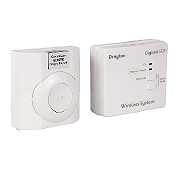 |
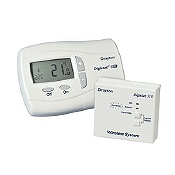 |
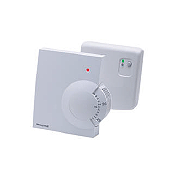 |
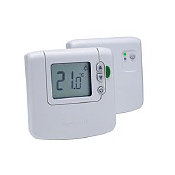 |
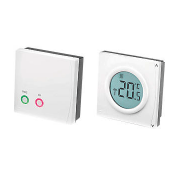 |
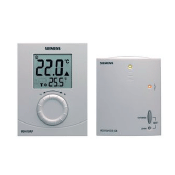 |
|
| Price | £109.00 | £110.00 | £96.00 | £89.00 | £160.00 | £59.00 |
| Display | Dial | Digital | Dial | Digital | Digital | Digital with dial |
| Combi only or all boiler types | All boiler types | All boiler types | All boiler types | All boiler types | All boiler types | All boiler types |
| Weather or load comp or neither | Load | Load | Load | Load | Load | Neither |
| TPI controls | No | No | Yes | Yes | No | Yes |
| Boiler Plus for combi boilers | No | No | No | No | No | No |
| Boiler Plus compatible for system, heat only | Yes when paired with a programmer | Yes when paired with a programmer | Yes when paired with a programmer | Yes when paired with a programmer | Yes when paired with a programmer | Yes when paired with a programmer |
| Warranty | 1 year | 1 year | 1 year | 1 year | 1 year | 2 years |
| 1 channel or 2 channel | 1 channel | 1 channel | 1 channel | 1 channel | 1 channel | 1 channel |
| Heat zone capability | 1 zone | 1 zone | 1 zone | 1 zone | 1 zone | 1 zone |
3) Boiler Plus requirements for new boiler installations
New minimum efficiency standards were introduced in April 2018 aimed at reducing the amount of fuel we use to heat our homes. It is now mandatory for every new boiler installation to be fitted with a programmable room thermostat and, for combi boilers, an additional energy saving measure:
There are three minimum requirements that must be met:
- Every boiler installation must have an ErP efficiency of at least 92% (see our Guide to Boiler Efficiencies).
- All new boilers must be fitted with time and temperature controls e.g. a programmable room thermostat, if not already present
- An additional energy saving measure must also be installed for combination boilers from the following list (a-c are all advanced heating controls):
a. Weather compensation control
b. Load compensation control
c. Smart control with automation and optimisation functions scheme
d. Flue gas recovery unit - this sits above the boiler and recovers heat from the flue. It is reported to reduce gas consumption by upto 4%.
Quick guide to Advanced Heating Controls for combi boilers
Measures A and B are forms of advanced heating control designed to work with modern ‘modulating’ boilers, i.e. they can adjust the output of the boiler to meet a varying demand. For example they can lower the output during spring and autumn months and increase it during winter. Measure C uses AI to learn your heating patterns. Optimisation technology learns when to bring the boiler to meet your desired room temperature in the most efficient way (for more see our Guide to Advanced Heating Controls).
The common aim of all advanced controls is to ensure the boiler is on for the shortest possible time to meet the room temperature. Standard controls tend to overshoot the room temperature by 1 or 2 degrees which is very inefficient. Advanced controls reduce the heat output of the boiler as it approaches the desired temperature to prevent overshooting. The net result is a reduction is gas use and lower fuel bills.
TOP TIP make sure your advanced heating control is compatible with your preferred boiler. If the advanced control uses weather compensation, load compensation or both then the control and the boiler must be able to communicate with each other in the same ‘language’. Most boiler manufacturers use a bespoke language that means only their ‘compensation’ controls can work with their boilers. Some boiler and control manufacturers have adopted the ‘Opentherm’ language which means that differ products, such as a Honeywell control and Baxi boiler can speak with each other. See our Guide to Opentherm products and alternative controls
4) Which control do I need to comply with Boiler Plus?
Slightly different minimum requirements apply depending on boiler type (combi, heat only or system) and whether the heating control is being fitted to an existing installation or fitted as part of a new boiler. The boxes below set the requirements according to your circumstances. Remember to fit a compatible Boiler Plus product. If you are fitting a new boiler with a smart heating control we strongly recommend you review our Guide to the Best Smart Controls or Guide to Opentherm products and alternative controls for non-smart products.
New installations of a heat only or system boiler:
require time and temperature controls, i.e. a programmable room thermostat or a thermostat with separate programmer.
New installations of a combi boiler:
require the same time and temperature control but with an additional ‘advanced’ energy saving feature, i.e weather compensation, load compensation or smart controls that combine automation and optimisation features. (Or a flue gas recovery unit)
New installations of a combi boiler:
require the same time and temperature control but with an additional ‘advanced’ energy saving feature, i.e weather compensation, load compensation or smart controls that combine automation and optimisation features. (Or a flue gas recovery unit)
5) Jump to more specialist pages on heating controls:
Review and compare Smart Controls, including Boiler Branded smart controls, also referred to as remote heating controls, internet controls and wifi controls.
Review and compare 32 thermostatic radiator valves by style and budget: standard, premium, chrome and budget.
Read our guide on wireless heating controls, both standard and smart controls, and the boiler plus scheme.
Review and compare Home Automation systems including Honeywell Evohome and Drayton Wiser
Read more about Advanced Heating Controls and the Boiler Plus requirements
Review and compare smart radiator valves, including compatible smart heating controls.
6) Jargon Buster
Thermostats and Programmers
A thermostat sets the desired room temperature whilst a programmer gives the user great control of the times the heating is on. A programmable room thermostat is a combined unit that does both. There are two main types of programmer: 1 day and 7 day (although some with a 5/2 day options). Most programmers will allow you set 2-6 time periods per day and also set different temperatures for each time period. If you only have a thermostat then your boiler will fire on and off all day unless 1) you turn the thermostat down when you out or 2) you switch the boiler off when you go out.
Single Channel and Twin Channel Programmers
A ‘channel’, like a radio channel, is the means by which the thermostat communicates with the systems it controls.
A programmable room stat will have commonly have one (single) or two (twin) channels, although some have three. The first channel will control the boiler. The second channel will control the hot water.
Single channel programmers
These are used with combi boilers, as it is not necessary to control the hot water separately (this is done by the boiler).
Twin channel programmers
These are used with regular and system boilers where the programmer needs to control the heating and the hot water timing. (They can also be used with combi boilers where there are two separate heating circuits or a mix of radiators and underfloor heating).
Three channel programmers
These work with regular and system boilers to control two separate heating circuits plus the hot water. These are only used in larger properties where the ground and first floors are separately piped to create two radiator circuits (called zones) or where there is a mix of radiators and underfloor heating.
Load and weather Compensation
‘Compensation’ controls are a form of advanced control that operate the boiler more efficiently.
Load compensation takes the difference between the lower internal room temperature and the desired room temperature and adjusts the boiler’s output to close the gap as efficiently as possible.
Weather compensation works in the same way but uses the external temperature. This traditionally involved a temperature sensor on the outside of a property linked to the internal programmer/thermostat. The sensor is able to forewarn the boiler of a change in outside air temperature which will eventually lead to a decrease or increase of inside temperature.
Some weather compensation systems use data from the local weather station to inform your heating system of a change in temperature. This is less accurate but makes for a more straightforward installation with fewer parts to go wrong.
For both weather and load compensation controls, the boiler can respond by increasing or reducing its output slowly to meet the predicted change in temperature. This leads to less ‘cycling’ (the boiler coming on and off) and more efficient periods of operation. NB for a control of this type to work it must speak the same ‘language’ as the boiler - for more go to our Guide to Advanced Heating Controls or try our Guide to Opentherm products and compatibility.
Smart controls with automation and optimisation functions
Smart controls (NB this is not necessarily an internet control) for the purposes of Boiler Plus automate the time and temperature settings based on occupancy detection, geolocation and/or stored data from user patterns over time. Smart controls work on a learned schedule of use and how quickly your home loses or gains heat. Over time the control will know how early the boiler will need to come on to meet the set temperature operating in its most efficient condensing mode. Smart controls of this kind work with all boilers. For more go to our Guide to Advanced Heating Controls.
Modulating boilers
All modern boilers are ‘modulating’. This means that they can adjust their output up and down. For example, an 18kW rated boiler can adjust its output to fire between 3kW and 18kW. Why is this important in a section on heating controls? Well in order for a modulating boiler to modulate, and thereby achieve its maximum efficiency, it must 1) work with a compatible ‘modulating’ heating control and 2) spend as much time as possible in ‘condensing’ mode, which can be achieved with the right heating control. For a boiler to modulate it needs to work with a compensation control that can speak the same language as the boiler. For more go to our Guide to Advanced Heating Controlsor try our Guide to Opentherm products and compatibility.
Smart – internet - heating controls
Smart heating controls are all programmable thermostats that are connected to the internet and operable via a smart phone app. Most use some form of advanced heating control (i.e. weather compensation, load compensation and/or automation/optimisation features). Many are now compatible with Alexa, Apple, IFTTT and other smart home devices. This can provide additional functionality, for example you can turn your heating on and off via the voice activated smart home device or active geofencing sensors (the heating will come on as you near home via a GPS signal from your phone). NB some smart controls such as Nest and Tado come with geofencing as part of the device. For more on smart controls try our Guide to Smart Heating Controls or Guide to Home Automation Systems.
7) Zoning
Conventional zoning is really only worth undertaking in larger properties. It involves piping two heating zones, usually ground floor and first floor. Each zone is controlled by a separate thermostat, allowing you to set different temperatures on each floor thus saving energy. For example, 21 degrees downstairs and 16 degree upstairs.
If you are extending your property significantly, you may wish to consider separating the ground and first floor radiators in this way. It will involve re-plumbing parts of the system and additional pipework, as well as adding zone valves to each circuit.
Thermostatic Radiator Valves
For smaller properties, the work and cost involved in re-piping the system to create two zones is rarely worth it. There are more cost effective, and less disruptive, ways of achieving variations in temperature.
The conventional way is to fit Thermostat Radiator Valves (TRVs). This will allow you to control the temperature of each radiator, e.g. turning off radiators in little used rooms and turning them down in the bedrooms. This is a manual exercise but once done rarely needs changing. TRVs can be fitted to most radiators by a plumber. For a comprehensive review of 32 TRVs regard our Guide to Thermostatic Radiator Valves.
Smart Radiator Valves
Smart radiator valves will also individually control heat radiator, the difference is that the temperature can be controlled by a central programmable room stat. Smart valves can be grouped together to operate as a single circuit or controlled individually. They are a very easy fit to most radiators.
Smart radiator valves are compatible with Honeywell Evohome, Heat Genius, Nest and Netamo smart controls – for more detail read our Guide to Smart Thermostats.

